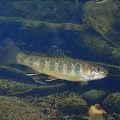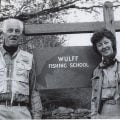Interview with Kris Keller, Montana Fly Company’s Overseas Factory Guru

Kris Keller showing the ladies how it's done
MidCurrent recently talked to Kris Keller, a 24-year-old self described fishing and fly-tying addict who’s one of the people in charge of Montana Fly Company‘s overseas factory operations. We asked him what his day-to-day routine is in a foreign fly-tying factory, what his fishes for in South East Asia, and what tastes better, Madagascar Cockroach or Ant Larva?
MidCurrent: Give us a little background about yourself. You’re from Montana correct? Where exactly?
Kris Keller: I’m 24 years old. I was raised in Dillon, Montana. I now live in Great Falls. I have fished in Thailand, Alaska, Honduras, Yucatan and Baja. I’m addicted and am usually fishing where ever I go. If I’m not on the water, I’ll most likely be out chasing birds with my dog or tying bugs.
MidCurrent:
I know you got started fly tying at a pretty young age. How old were you when you got your first vise? Obviously you fished too. When did you start that? At this point in your life what do you like more fishing or tying bugs?
Kris Keller: It came as a package deal for me. I was about 10. My mother worked with Dick Sharon and he gave me a Scott SES fly rod with the “Successful Fly Fishing Strategies” videos that he and Gary Lafontaine made. Those videos never came out of my VCR. Of course fly tying shortly followed. My best friend’s dad growing up, Dave Borjas, is a commercial tier. This is where I got an understanding on what fly tying was. My buddy and I would “borrow/test” his flies and tie ours when he wasn’t around. We’d lock ourselves in his tying room and go over books on old George Grant’s stuff and original hand-drawn blueprints of Al Troth’s flies.
Fishing or tying? That’s a tough question. For me tying flies only fuels the angling fire… and vise versa. I tie flies in my head all the time; while I’m fishing, driving, or when I’m talking to my girlfriend.
MidCurrent: Did you ever guide? Where? What rivers? What about any other gigs in the fly fishing industry?
Kris Keller: I mainly guide on the Missouri River but I started for Tim Tollett in Dillon. I’ll go whereever. On my third guide trip, Tollett gave me a half-day trip to the Madison and one of my clients got struck my lightning. I worked at R.L. Winston when I was 19. After that I took a year off of school to figure out what I wanted to do with the rest of my life. I had my mind set that I was going to be in the fly fishing industry, I just didn’t know where.
MidCurrent: From what I understand you have 25 patterns that are now tied commercially with Montana Fly, correct? That’s quite a few. What are some of your favorites? Why?
Kris Keller:
Dream Catchers – They’re on the top of the list right now for me. I have been consistently finding nice fish with that fly. The fly has a mottled look and a deer head front to push water, which really makes the articulation boogie in the water.
Camp Counselors – Nothing is better than having people who have fished a fly of yours get goose bumps when they tell you triple-digit topwater tarpon stories.
MidCurrent:
You now live in Thailand or Cambodia if I’m not mistaken. You’re the lead designer for Montana Fly overseeing and training local tiers there correct? Tell us a little bit about that. What exactly is your title? What’s a typical day consist of for you?
Kris Keller: Yep, and I’m loving it! I’m definitely not lead designer. I did help a ton with the new MFC patterns this year. I’m doing a few different things at the moment. I’ve been traveling to new factories, duplicating custom flies and adding new fly submissions for 2013.
I help with training up the new tiers or introducing new flies. I also help with the quality control—I’ll walk the floors to make sure that the flies are looking consistent. I check out thousands and thousands of different flies in a month. Then before they get shipped, we do a final QC to make sure they are all fishable, the materials are good, and they are all in cookie-cutter form from factory to factory.
For new fly samples, I enter the recipe into the system. Then I will pull all of the materials and work with the tiers to dial in the pattern. While this process is going on I will document the steps and follow key notes from the fly designer. Once we think the fly is set, we’ll contact the designer with pictures of the fly. Then I will give the go ahead and put them through production. As they are being tied I will triple check with the tiers, making sure the flies match up to the factory sample.
MidCurrent: What’s your favorite part of the job?
Kris Keller: My favorite part is actually the job itself. I’m excited to go to work every day. I get to travel around and see new things. I’m doing what I enjoy and am working with a lot of different people daily, whether it’s tiers, fly shops, or dealers around the world. It is all very social and fresh.
MidCurrent: What’s the worst part of the job?
Kris Keller: The worst part would be communication at the factory. Something that seems like it should take 30 seconds can easily last a half hour…. Rosetta stone here I come! The other thing is working with different fly patterns day in and day out—all I can think about is fishing.
MidCurrent: Do you ever get to fish or does the factory work keep you pretty busy? If so I assume there’s gotta be some fish that we’ve never heard of swimming around over there. What are they? What type of flies do they eat?
Kris Keller: I have been fishing a little bit, yes. Not as much as I would be if I was in Montana with a 45-degree winter and a tailwater 30 minutes away. There are a lot of different fish around but I’ve only angled for Mahseer. I’m a little busy right now but next year I’m going after big Snakeheads on top water.
Thailand fly fishing is by far the biggest experience I have had yet. Like most Thailand stories it starts out in Bangkok. From there it’s only a one-hour plane ride and three-hour car ride that ends in a fairly primitive jungle. Fishing in gin-clear water for Masheer. Chiang Mai Fly Fishing has a pretty sweet thing going to restore the Mahseer fisheries and help support the local Karen Villages. Mahseer will eat everything including the picnic basket. They are omnivores. The best is trying to get them on a fig fruit. It looks like a big red indicator. We call them “Cherry Bombs” for one reason: when the bomb is on the water, the way Mahseer explode on them is exciting. The only problem is getting them to commit to your fly and then actually hooking them.
I’m starting to figure them out a little more every time and have a couple new tricks up my sleeve. The best way to understand what Mahseer fishing is would be to watch our new film “Thai One On” when it comes out.
MidCurrent: Last question. What’s the weirdest thing you’ve eaten in while living in South East Asia? How was it? Would you recommend it to visitors?
Kris Keller: I enjoy trying different foods. The weirdest would be ant larvae in scrambled eggs. It was good; they kind of had a sweet pop to them. They look like an oversized maggot. I ate a fried Madagascar cockroach as well. The inside of the cockroach had a gritty, creamy texture. This would be something you would want to eat with a cold Leo beer in your pocket and some Big Red.
Oh, and I would recommend fried grasshoppers to everyone. They could be a bar snack. They taste like French fries. Then you can use the legs as a toothpick.
First Glance: Costa's New Double Haul Sunglasses
RIO Products Introduces New Package with Skagit Flight VersiTip











